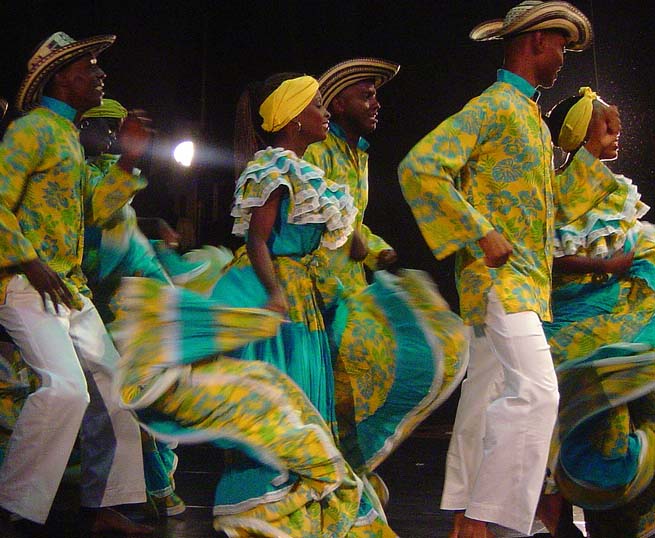SAN BASILIO DE PALENQUE — “Everyone needs to eat from agriculture. The pope, the bishop and the priest. Silversmiths and cabinet-makers, clothing clerks, storekeepers and the farmer, too. Who can take care of us — who, if the farmer doesn’t sow?”
Domingo Rocha, a farmer in San Basilio de Palenque, in the Bolivar region of northern Colombia, is singing the nostalgia brought on by the ever-decreasing importance of his lifelong profession. Like many other older people in this town south of Cartagena, Rocha — who is known locally as Mingo — is worried that the younger generations have lost the local peasant traditions. Worse, he says, they don’t even know the names of the different plants and fruits that grow in this inland stretch, 50 kilometers from the Caribbean coast.
In fact, a recent study showed that older people in Palenque know, on average, 64 edible plants native to the region — while their grandchildren only know of 36, and the majority of those they don’t ever eat because they consider them unappetizing.
Young people in Palenque admit their ignorance when it comes to the plants that grow in the hills and dry forests in this small town, which were analyzed by the Interdisciplinary Center of Development Studies (Cider) of the University of the Andes as part of research on edible plants in Afro-Colombian history.
Palenque is an important town in that history. It was founded in the 16th century by escaped slaves, and is considered the first free town in the Americas. The residents of Palenque were able to live relatively isolated — and thus free — from outside influences for centuries, and most residents today are of African heritage.
Margaret Pasquini, the research director, said that, “rescuing the knowledge and culinary traditions is of vital importance, if you keep in mind that these plants can bring food and nutritional security to the communities, and in addition, contribute to the creation of a cultural identity for the descendants of Africans in Bolivar.”
 Protecting banana plants on the Caribbean island of St. Lucia (Fairsing)
Protecting banana plants on the Caribbean island of St. Lucia (Fairsing)
But consumption of native plants is low in Bolivar, according to the Cider study, as it is in many other places. That could explain the concerning levels of malnutrition that plague the region.
What's been lost
According to a report from the United Nations Development Fund, in 2012 the rate of malnutrition for children 5 and under in Bolivar was 9.%, higher than the national average of 7%. That means that almost 10 out of every 100 children are either moderately or severely underweight.
“Why have these things been lost?” asks Guillermina Gonzalez, a 68-year-old woman from Palenque. “Because your grandparents did it, your mother didn’t and now the daughters of your mother don’t do it either. The woman used to go out to the hills together to harvest plants, and now they have to go to work."
Gonzalez continued, with an eye on the modern kitchen: "Women think that food doesn’t have any taste unless they throw in a bouillon cube, even though some chilies and cilantro used to be enough. Now people are worried that they need garlic and they have to run to the store to buy it, because no one grows anything in their yard anymore.”
According to Josefa Hernandez, a Palenquera and a language advisor with the Ministry of Culture, there are plenty of plants that can grow in Palenque: spinach — used to prepare a juice to strengthen the immune system — sapote, cucumber, pumpkin, guazuma, avocado, yams, mamee apples, and beans for everyday consumption, traditional medicinal plants like balsam apple, and the famous bleo (a leaf with high nutritional value that the older generation used to add to soups).
“Pizza came to Palenque and it stayed,” Hernandez said. “Now everyone wants things that are easy to prepare and prefer to buy them in the store rather than growing them and cooking them.”
 Fiesta Palenque (Steven Joyce)
Fiesta Palenque (Steven Joyce)
Hernandez explained that, even if the legacy of traditional plants has been lost for cultural reasons, farmers also don’t have any incentives to conserve their knowledge. “When farmers go to sell their products, they encounter a market with very low prices, that don’t even allow for subsistence. Who is going to continue growing under those conditions?” she asked.
School gardens
Hilson Baptiste, the Minister of Agriculture in Antigua and Barbuda was recently quoted as saying that the region around the Carribean has "a nutritional crisis” that requires every country figure out ways to feed its own people.
That is why in Jamaica, Haiti, Bahamas and other Caribbean nations, residents are reclaiming their agricultural past.
In Jamaica, for example, food imports doubled between 1991 and 2001 and farmers went broke. Now stores label local products with signs meant to incentivize buying them — while the government has given out thousands of seed kits meant to kickstart domestic agriculture, and 400 schools have food gardens that are tended by the students and the teachers.
In the Bahamas, around $350 million is invested in food imports every year, representing between 80 and 85% of the agricultural market in the country. The Bahamas is creating a Nutritional Sciences Institute that intends to teach students about better agricultural practices.
According to Erecia Hepburn, the development coordinator for the Institute of Marine Sciences and Agriculture at the University of the Bahamas, the academic program will include training in making a profit with agriculture, aquaculture, agricultural management, environmental conservation and agro-industry.
Back in Palenque, the schools have established a student garden program, and a group of women are trying to sell desserts based on traditional plants. For Joaquin Valdez, a local resident of African heritage, the disappearance of this culinary and nutritional legacy is alarming.
“The first thing that gave us security when we came to America from Africa was the forest and the hills, where we found the solutions to our health and nutritional problems," he said. "That is where we were able to put into practice the one and only thing we were allowed to bring from our continent: knowledge.”





